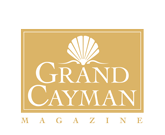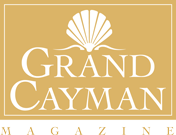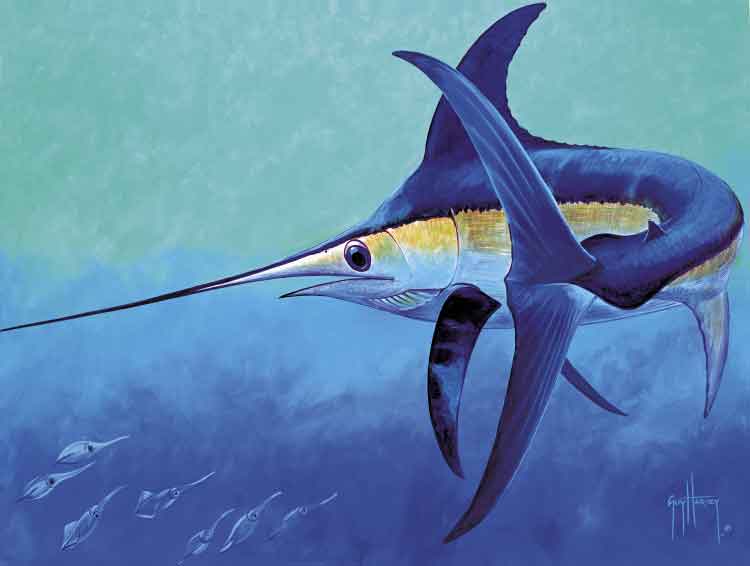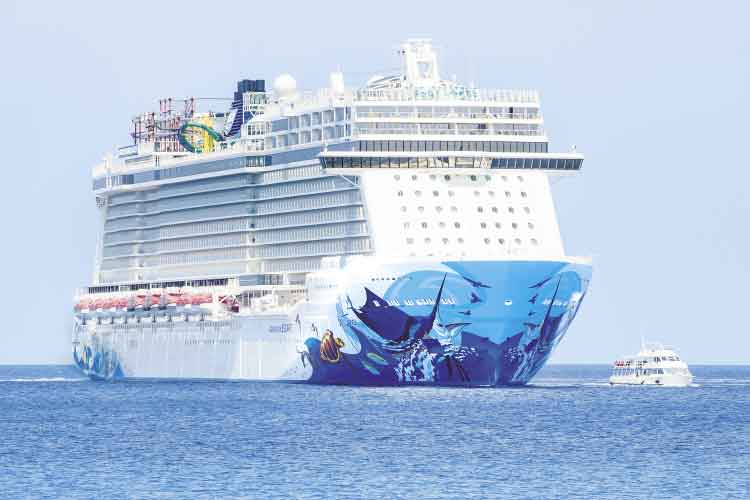“Doctor Harvey, I presume?” That was how I would start the conversation, setting the tone with my incredible wit.
Or maybe I’d make some funny reference to a hook.
I went through the options in my mind as I pulled up to an impressive dwelling that would not have been out of place at the center of a Jamaican plantation.
Maybe I’d just open with “Hello.”
I had an appointment with award-winning painter and marine conservationist Guy Harvey on that sunny Friday morning – a man I had known socially for many years, but whose history I was yet to learn.
I first interviewed Harvey in the early 2000s and at that time I simply thought of him as a guy (ha-ha) who painted fish. I’d seen a few of his pieces around Cayman; impressive paintings of almost life-sized marlin and sharks converting the walls on which they resided into windows to the ocean.
I knew his family was Jamaican and that he was a self-taught artist, but back then I had no idea of the man’s following. My first inkling that his name was known beyond the boundaries of the Caribbean was when I was driving along Interstate 95 in Florida and a truck passed me in an adjoining lane. As its obviously dodgy shock absorbers fought to keep its chassis in one piece, I could clearly see a Guy Harvey sticker clinging to its bumper – that unmistakable signature shaking violently before my eyes while the driver optimistically accelerated.
After that sighting, it seemed the blinders had been removed. I was seeing Harvey’s work everywhere. Men were wearing shirts with the trademark logo on them; his prints appeared in onboard cruise ship art auctions; he was in the news, on television, and featured in magazine articles either talking about his art or his conservation efforts. He appeared to be making a bit of a success of this fish painting thing.
As I parked the car, he came out to greet me – a big smile playing across his face. “Hi Vicki!” he said.
“Hey Guy!”
So much for my witty opener.
He led me upstairs to a large, bright room with high ceilings that assumes many roles: it is his library, his office and art studio. It reminded me of rooms in great houses and resorts in Jamaica, taking me back to a trip I once took to Strawberry Hill in the Blue Mountains. Huge windows let in swaths of natural light, highlighting bookcases, sculptures, artwork and numerous photos of Harvey, his family and celebrities he has met over the years.
Three big dogs descended upon us as we walked in the door, oblivious to the calls of Harvey’s daughter Jessica, who was working at a laptop in the corner. I managed to get to a chair using a combination of baby talk and petting. Satisfied that I wasn’t there to steal anything, they quickly settled and flopped at my feet for the remainder of the morning.
Early days
Guy Harvey was born in 1955 in Germany on a British Army Base to Josephine Harvey (nee Williams) and Philip Harvey. The Williams family had emigrated to Jamaica from Wales in 1664, and although Philip Harvey served in the British Army and met his future wife in London, he too was from Jamaica. In fact, the Harvey family lived next door to the Williams back on the island. It took traveling to a country thousands of miles away to properly meet the next door neighbor.
After 14 years in the Army, his father decided to move the family by ship back to Jamaica in early Feb. 1956. On Feb. 18 they arrived at the family cattle farm – “Woodstock” – a 1,260-acre property 1,100 feet up in the hills, about 15 miles inland from the south coast in Westmoreland Parish.
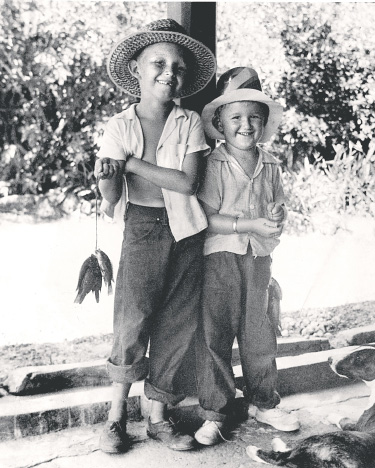
It would be the beginning of what Harvey recalls as being a “fantastic childhood,” full of outdoor adventures that included horseback riding, nature walks and what would become his favorite pastime – fishing.
“Mum was a very keen horse rider … we went on rides every day,” he says. “She was a naturalist; she loved pointing out birds and teaching us to learn the names of birds and flowers and plants, and I appreciated that from very early on.
“She definitely spotted my artistic talent from that age … [when I was] five or six [years old].”
Both of Harvey’s parents loved fishing – he has a picture of his mother with her first marlin (203 pounds) and his father’s marlin just slightly heavier at 206 pounds; the fish were caught on a trip from Bluefields to Montego Bay in 1962.
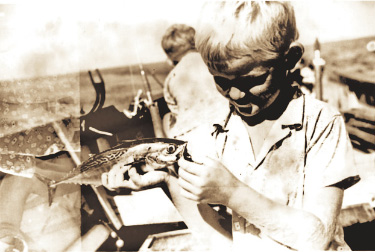
“I liked [fishing] more than anything else,” he laughs, “and mucking around in the water.”
They lived 20 miles from Savannah Mar and 22 miles from Montego Bay with no schools nearby, and so for the first few years of Harvey’s life he had a governess. That all changed at the age of 5, when he was sent to Kingston to live with the Cruickshank family in order to attend school in the island’s capital. He was not happy with the arrangement, but at least every school holiday meant a trip home on the diesel trains that were running at the time.
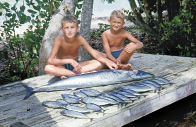
After spending three years in Kingston, Harvey was sent to Marlborough House in Kent, England, flying back once a year for summer holidays on BOAC. “That was the highlight of the year, [getting to go] home … and to leave was just awful,” he sighs. “I remember those days; I got so homesick.”
Despite never getting used to the cold and missing home, Harvey threw himself into sports, finding himself to be proficient in cricket, soccer and the school’s shooting program. He set records in shooting that still stand today.
It was at this school, when he was 11 years old, that his art teacher, Gillian Cresswell, really began to encourage his creative streak and affinity for nature. This was the age when, for the first time, Harvey began to explore his artistic talent.
“It was an escape for me,” he says.
Although his main subject matter was nature, he was also influenced by what he calls the “trash mags” of the time – war stories with hand-drawn illustrations of ships, planes and tanks. He created sketchbooks of his own drawings of similar machines, spending all his pocket money on model airplanes.
Not everyone was as supportive of Harvey’s creativity. A school report from his obviously frustrated French teacher stated he was “quite formidably idle” and advised that he should “give up drawing Spitfires in prep and get on with the job.”
The Parisian diplomat he might have become was a future officially lost when, at the age of 17, Harvey was given a book by his mother. The gift of “The Old Man and the Sea” by Ernest Hemingway proved to be the turning point in his life.
“The copy she gave me didn’t have any illustrations,” he says. “I subsequently found one with [them], but I thought I could do a much better job.”
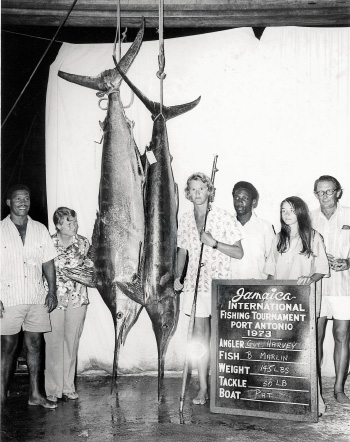
Now 18 years old, the young artist decided to put his pen and ink where his mouth was, and he began to draw. The project took him a year and the series of illustrations later launched his art career.
It would be about 10 years before the world first caught a proper glimpse of Harvey’s true creative potential. His lack of interest in school changed as he grew old enough to realize the money his education was costing his parents, and he began to buckle down. “I woke up, academically,” he recalls.
He was accepted at Aberdeen University to study marine sciences, and by the third year was deep in the throes of oceanography, which he loved – so much so, that he elected to do an honors year, meaning an extra year in Scotland. It was worth it; he achieved a First Class Honors Degree.
He dived the frigid waters off the west coast, encountered a wealth of marine life, and was an active member of the university swim team. Life was good.
The plan was to now return to Jamaica to study for his PhD. He joined the Fisheries Ecology Research Program under Professor Ivan Goodbody at the University of the West Indies in Kingston.
Each day he would drive out to the Port Royal Marine Laboratory to research coastal pelagic species, subjects that now appear in many of his paintings. He was also actively participating in the fishing tournaments that he had so longed to be a part of when he was younger.
“Every single marlin that ended up in any tournament, I got to see it and cut it open and collect a lot of data for people who were doing work on billfishes,” he says.
Throughout his studies, Harvey was painting, displaying and selling his pieces at the tournaments he was helping to organize. A burgeoning secondary career was beginning to materialize.
First Art Show
In 1985, Harvey made a limited series of 12 prints from the original illustrations he had created for “The Old Man and the Sea,” enabling him to hold his first one-man art show at Round Hill near Montego Bay. The popularity of the prints, which subsequently sold out, spurred him on to hold another show that same year.
 His girlfriend Gillian Watt, who he had started dating on New Year’s Eve 1984, insisted that he get help to arrange the exhibitions.
His girlfriend Gillian Watt, who he had started dating on New Year’s Eve 1984, insisted that he get help to arrange the exhibitions.
The daughter of a well-known and respected racehorse breeder in Jamaica, Watt helped him organize his show while three sponsors ponied up the money for costs like framing and creating the prints. Although he was a budding businessman, Harvey was also studying for his doctorate, making time and money precious commodities.
The sets of prints were priced at J$1,200 each – approximately US$200 at the time – and some people bought five sets. He also donated a set to the International Game Fish Association’s annual auction in Palm Beach, which subsequently sold for US$2,500.
“I thought ‘Wow – Okay!’” laughs Harvey, who probably never predicted that they would now be worth US$30,000 each.
The 60 original pen-and-ink drawings are a permanent exhibition at the Key West Custom House Museum and are privately owned. “They were in a gallery in Key West, and I just slapped a price on them thinking no one would ever be able to afford them. This guy bought them, and I was gob-smacked! Of course, Gillian was very upset [with me],” says Harvey.
But all’s well that ends well. Only last year the private owner informed the artist that he wants to give them back to him as a gift.
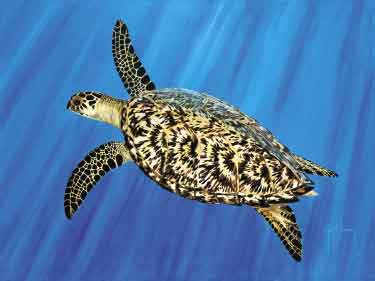 Harvey also published a book of the illustrations, which he named “Santiago’s Finest Hour” with the blessing of the Hemingway family.
Harvey also published a book of the illustrations, which he named “Santiago’s Finest Hour” with the blessing of the Hemingway family.
Sadly, his father passed away in 1983 and so never got to see the success that his son would make of his artistic talent.
Getting the word out
Harvey was now managing to make inroads in the U.S. through the connections of Barbara Dailey (nee Currie), a photojournalist, and Scott Boyd, a tackle store owner. Between them, they put him in touch with “all the right people,” leading to Harvey signing with a T-shirt company that same year. It was the start of what would become a merchandising goldmine.
In 1986, he got his art into the Fort Lauderdale Boat Show and fortuitously met people in the printing industry. It wasn’t long before contracts were signed, licensing the use of his art for apparel.
Four-color process printing had now taken over from block printing, and Harvey’s artwork popped on the clothes.
“It looked really cool,” he says. “And there was nothing else like it … people just loved it.”
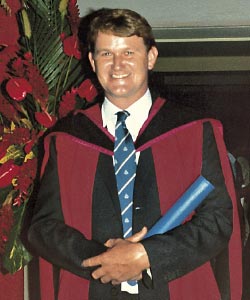
The man who had the vision of Guy Harvey futures was fisherman Raleigh Werking, the owner of T-Shirts of Florida, Inc. The collaboration between the artist and the businessman quickly translated into booming sales and the Guy Harvey name began to filter across state lines to other parts of the U.S.
Harvey had now finished his PhD, was teaching part-time in Jamaica at the university, and taking weekly trips to Florida to work on the two businesses he had started there. No fancy offices had he – he was running everything out of Boyd’s tackle store with Boyd’s daughter assisting with the administration of it all.
Big changes
By 1988, Harvey’s art business was taking off to the point that juggling that and the teaching position was proving to be too much. He resigned from the university that year and on Jan. 7, 1989 he married Gillian.
The three years prior to that had been quite eventful for him. In late 1986, he bought a house in Kingston. In Jan. 1987, both of his legs were severely injured by a boat propeller, leaving him unable to walk for a year; and in Jan. 1988, he survived a shootout in a home invasion – 14 bullets sent in his direction and all of them missed. The Jan. 1989 wedding was perhaps an attempt to break the curse of the previous anni horribiles.
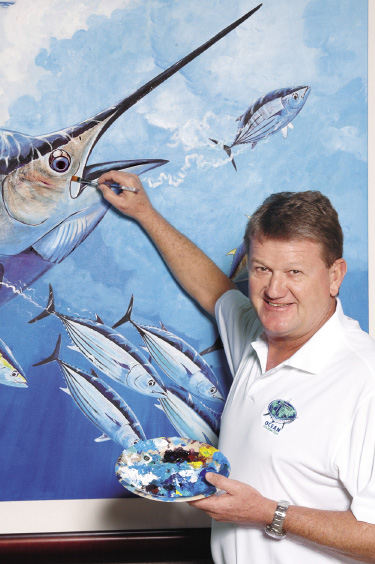 Harvey was now holding six art shows a year in the U.S. in Florida, New Jersey and California, a cycle that repeated for the next 10 years.
Harvey was now holding six art shows a year in the U.S. in Florida, New Jersey and California, a cycle that repeated for the next 10 years.
The number of licenses Harvey’s company held grew to include everything from apparel to tableware. “We had 20 different licenses at one point,” says Harvey, “and a publishing company that produced limited edition prints.”
He set up his own office in Fort Lauderdale and bought a house there which they kept until 1999; the same year they moved from Jamaica to the Cayman Islands.
“The advantages of living in Jamaica were overtaken by the disadvantages,” he explains.
The Harveys chose the Cayman Islands because it was part of the British Caribbean and Guy had been fishing and diving here since the 1980s. They closed up shop in Jamaica and moved – lock, stock and barrel.
Guy Harvey Research Institute
At the same time Guy, Gillian and their two children Jessica and Alexander were settling into their new home in the Cayman Islands, a lawyer by the name of Charlie Foreman was chatting with Harvey about marine conservation in Florida and how to start entering the world of philanthropy.
The Guy Harvey Research Institute started out with a donation of US$2,000 a year, originally piggybacked onto the Nova Southeastern University Oceanographic Center in Davie, Florida and the work it was doing, particularly on sharks. It now occupies the entire fourth floor of the main university building.
The Institute’s shark tagging program in Florida started around 1999 and in Cayman in late 2006, four years after the stingray tagging initiative – the important first ever study of a marine interactive program.
“The sandbar experience that has been going on for as long as we’ve been around provided the perfect opportunity to have access to wild animals, 365 days a year,” Harvey says. “We realized the potential for a long-term study because of the socioeconomic value of the interaction to the Cayman Islands.”
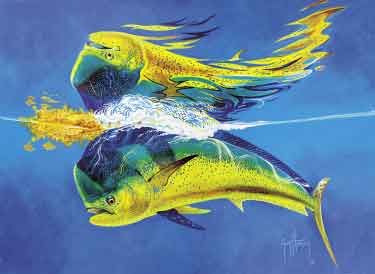 The Institute has expanded its ongoing studies over time, with a five-year plan in Panama set to start this year. It has produced 119 peer-reviewed publications since its inception.
The Institute has expanded its ongoing studies over time, with a five-year plan in Panama set to start this year. It has produced 119 peer-reviewed publications since its inception.
Go big or go home
Harvey could not be accused of being shy when it comes to his paintings, in that many of them dwarf the dimensions of your average 11” x 17” acrylic-on-canvas. The creatures that he chooses to portray, such as marlin, sharks and whales, beg to be replicated with a certain amount of respect paid to their size.
The mural at Nova Southeastern University is the biggest Harvey has ever painted – 300’ x 60’ feet – but possibly the most challenging mural project to date was a commission from Norwegian Cruise lines.
In 2013, the Norwegian Breakaway appeared with the New York City skyline on her hull, courtesy of artist Peter Max. She was followed by the Norwegian Getaway sporting a tropical scene, including a mermaid, painted by David “Lebo” Le Batard.
The Norwegian offices were located in Miami and Fort Lauderdale, so it was no surprise when they came knocking on Harvey’s door to discuss him joining the list. After the deal was struck, which included an annual donation from the company to the Research Institute, Harvey sat down with his graphic artist to work out the design. The next step was to transfer that vision onto the ship itself, the Norwegian Escape, which was being finished in Germany. Harvey flew out to meet his “canvas” in person in July 2015, painted part of the hull himself and conducted multiple news interviews, much to the delight of the cruise company. The size of this mural is particularly impressive – Harvey’s signature alone is 30 feet tall. The Norwegian Escape launched in Aug. 2015 and she can often be seen in Grand Cayman’s George Town harbor.
Travel highlights
Harvey has traveled all over the world, so trying to pin him down on some favorite locales is difficult. One of his most memorable excursions was to Mexico to view some frenzied feeding.
“It was Magdalena Bay, Mexico. We’re in the water with about 40 striped marlin and sea lions, all chewing down on these sardine baits,” says Harvey.
“I would never have put sea lions in with striped marlin had I not been there and seen it. [The crew] all ran out of [camera] footage, we all ran out of batteries, and we just sat there, in a circle [under the water], watching the marlin blazing the bait in front of us.”
“We also had [an amazing] expedition in Isla Mujeres, Mexico. We spend a lot of time there for different reasons, and one of them is the whale sharks. We were in the water for five days straight.”
Jessica Harvey, who for the most part had managed to get on with her work all through this interview, despite me and her father talking nonstop, interjected with enthusiasm: “You need to go, it is out of this world! Manta rays were 20 feet wide, and they were jumping, left, right and center, all around the boat!”
A family affair
Harvey has always included his family in his expeditions, particularly his children Jessica and Alex, taking them to some of his treasured places such as Costa Rica, Mexico, Panama and the Great Barrier Reef. They have both grown up loving fishing and diving, much as their father did.
As Project Manager in Cayman, Jessica manages the educational programs associated with the Guy Harvey Ocean Foundation and Alex is based in Florida, taking care of all the social media and marketing for the company. One only has to visit www.guyharvey.com to see that he must have his hands full. Apparently, a Ford F-150 Guy Harvey edition truck exists. Why buy a bumper sticker when you can get the whole thing?
Harvey is clearly proud of his children and enjoys having them involved in the business. He calls Jessica “the Stingray Whisperer” based on her affinity for corralling the animals so they can be tagged.
She and Louisa Gibson, a marine biologist who also works for the Foundation, have created a short documentary educational series called “Conserving Cayman,” which has been distributed to local schools. The plan is to make it available online on the Guy Harvey website for anyone to download.
Looking to the future
Guy Harvey certainly doesn’t show any signs of slowing down. The brand is going gangbusters, as they say in the business, and in July 2019 he will move his licensing contract to Perry Ellis International, gaining him even greater scope in the market.
He still really enjoys painting, which is good if he is going to keep up with his rate of 100 original pieces a year. Maybe he’ll add to his portfolio of TV programs and documentary films, or perhaps he’ll visit places on his bucket list, like the Indian Ocean, that he is yet to explore.
Whatever he does, he will no doubt take us along for the ride. We’re hooked.
















